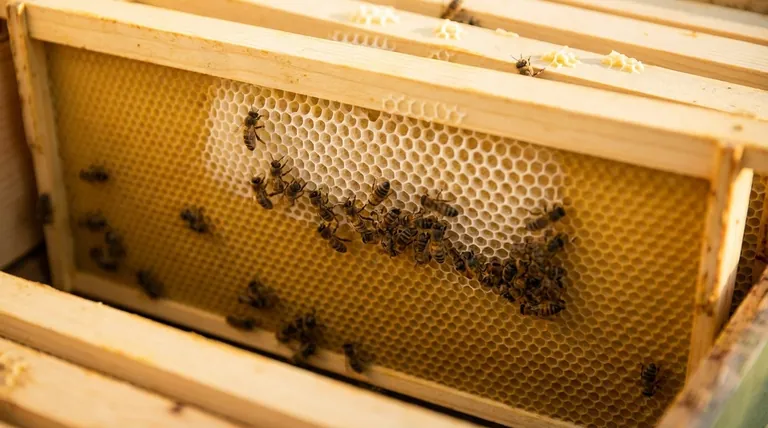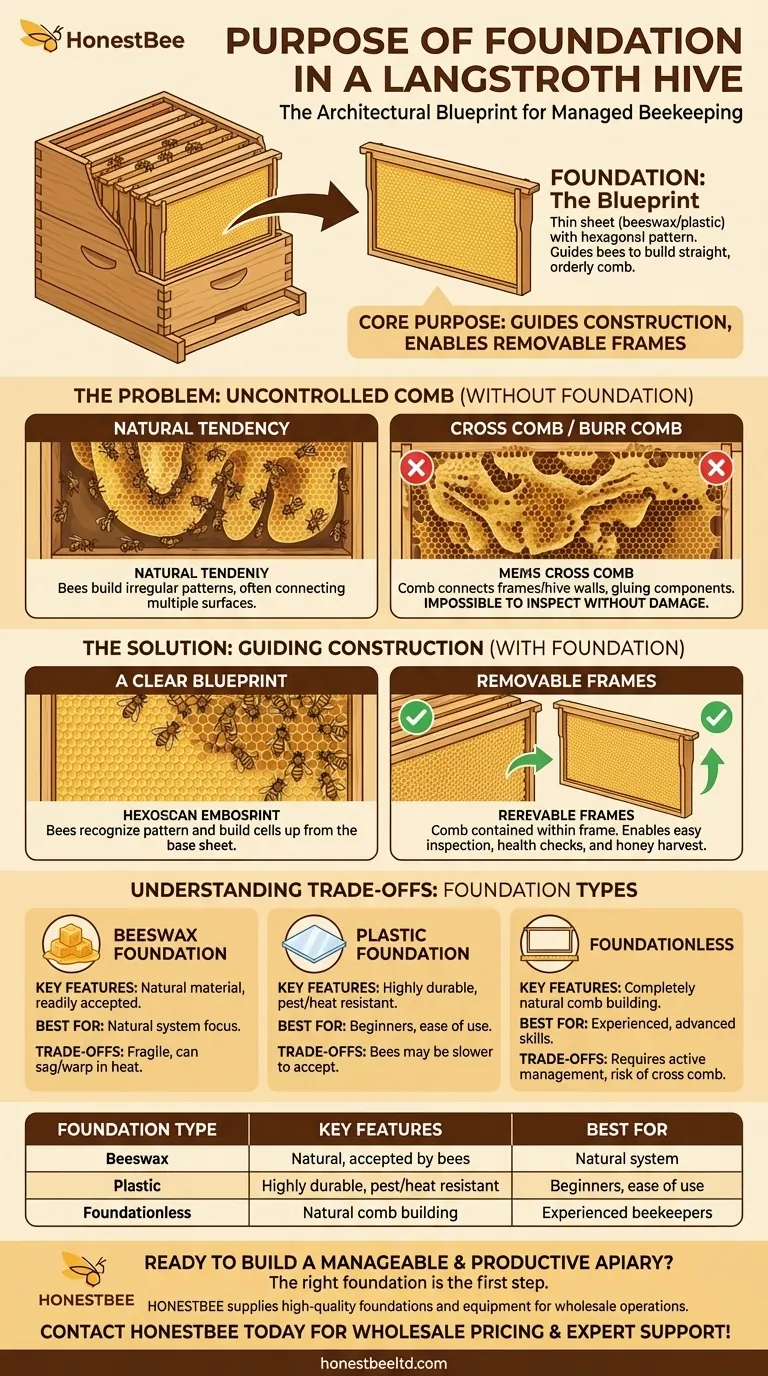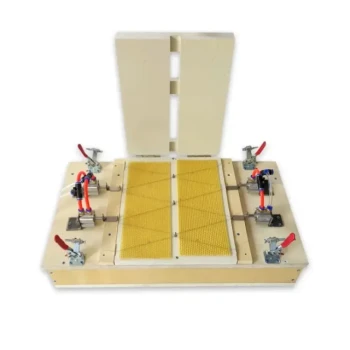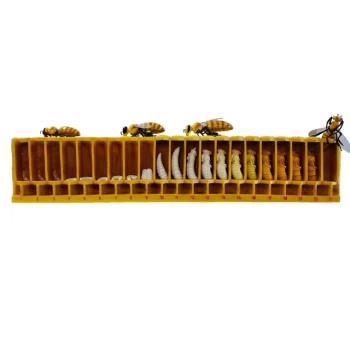In a Langstroth hive, foundation is the architectural blueprint provided to the honeybees. It consists of a thin sheet, typically made of beeswax or plastic, that is embossed with the hexagonal pattern of honeycomb cells. Its core purpose is to guide the bees to build straight, orderly comb directly within the removable frames, which is the defining principle of modern beekeeping.
The central role of foundation is not just to give bees a starting point, but to control where they build. This control is what makes the modern Langstroth hive's removable frames possible, enabling effective hive management, inspections, and honey harvesting.

The Problem Foundation Solves: Uncontrolled Comb
To understand why foundation is so critical, you must first understand the problem it prevents. Without guidance, bees will build comb according to their own instincts, which does not align with a beekeeper's need for inspection.
The Natural Tendency of Bees
Left to their own devices in an empty cavity, bees build comb in beautiful but irregular patterns. They often build curving walls of wax that connect to multiple surfaces, a behavior that strengthens their natural nest.
Why Uncontrolled Comb is a Problem
When bees build this way inside a modern hive, it results in cross comb or burr comb. This is wax that connects adjacent frames to each other or connects frames to the hive walls.
The comb effectively glues the hive's internal components together. This makes it impossible to lift out a single frame for inspection without tearing and destroying the comb, killing brood, and greatly agitating the colony.
How Foundation Works: Guiding Bee Construction
Foundation directly solves the problem of cross comb by providing an irresistible guide that channels the bees' building instincts.
Providing a Clear Blueprint
The embossed hexagonal pattern on the foundation acts as a powerful suggestion. Bees recognize this pattern and immediately begin "drawing out" the cells, building the walls of the honeycomb up from the base sheet.
Ensuring Straight Comb Within the Frame
Because the foundation sheet is secured inside the wooden or plastic frame, all of the new comb the bees build is perfectly contained within that frame's boundaries.
The Benefit: Removable Frames
This results in perfectly straight, independent combs. Each frame can be gently lifted out of the hive individually. This simple accessibility is the cornerstone of the Langstroth hive design, allowing beekeepers to inspect for disease, verify the queen's health, and harvest honey without disrupting the entire colony.
Understanding the Trade-offs: Foundation Types
The choice of foundation material involves trade-offs between naturalness, durability, and ease of use.
Beeswax Foundation
This is the most traditional type. Sheets of pure beeswax, sometimes reinforced with wire for support, are placed in frames. Bees readily accept and build upon it because it is their natural building material. However, it can be fragile and may sag or warp in very high temperatures.
Plastic Foundation
These are rigid plastic sheets, typically coated with a thin layer of beeswax to encourage the bees to use them. Plastic foundation is extremely durable, resistant to pests like wax moths, and will not sag in the heat. Some bees can be slower to build on plastic, but its ease of use and longevity make it a popular choice, especially for beginners.
The "Foundationless" Approach
Some beekeepers prefer to give bees no foundation at all, encouraging them to build completely natural comb. This requires a starter strip (of wood or wax) to guide them and demands very active management to correct any cross comb before it becomes a major problem. It is an advanced technique that requires significant skill.
Making the Right Choice for Your Goal
The best foundation depends on your beekeeping philosophy and management goals.
- If your primary focus is durability and ease of use: Plastic foundation is the most reliable and forgiving choice for new beekeepers.
- If your primary focus is a more natural system: Beeswax foundation provides a natural material that bees prefer, but it requires more careful handling.
- If you are an experienced beekeeper seeking natural cell size: A foundationless approach offers the most natural comb but demands expert-level attention and frequent intervention.
Ultimately, choosing the right foundation is about establishing a functional partnership with your colony, enabling you to care for them effectively while respecting their natural instincts.
Summary Table:
| Foundation Type | Key Features | Best For |
|---|---|---|
| Beeswax | Natural material, readily accepted by bees | Beekeepers focused on a natural system |
| Plastic | Highly durable, resistant to pests and heat | Beginners and those prioritizing ease of use |
| Foundationless | Allows for completely natural comb building | Experienced beekeepers with advanced skills |
Ready to build a manageable and productive apiary? The right foundation is the first step. HONESTBEE supplies high-quality beekeeping foundations and equipment to commercial apiaries and distributors through our wholesale-focused operations. Let us help you establish a strong partnership with your colonies.
Contact HONESTBEE today for wholesale pricing and expert support!
Visual Guide

Related Products
- Notebook Style Beeswax Foundation Mould Wax Foundation Mold
- Food Grade Plastic bee Foundation for Bee Frames
- Electric Flatting and Embossing Machine with Tray for Beekeeping
- Electric Beeswax Flat Sheet Machine with Operating Tray for Wax Processing
- Economy Manual Beeswax Embossing Mill Wax Foundation Machine Roller
People Also Ask
- What is the process for making beeswax sheets using a mold? A Step-by-Step Guide for Perfect Results
- What is required when using wax foundation in beekeeping frames? Essential Support for Strong Combs
- What are the uses of recycled beeswax cappings? Transform Honey Byproducts into Valuable Assets
- How is beeswax foundation installed and what are its characteristics? Boost Hive Health Naturally
- How do you use the Foundation Mold to create beeswax foundation? Master DIY Beekeeping with Precision
















